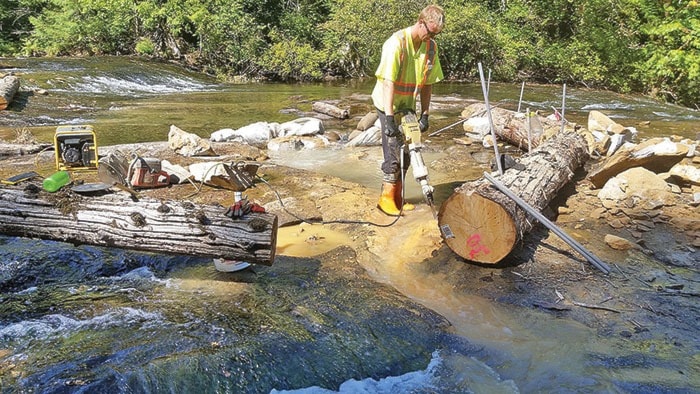
This photo shows the bolted-in-place yellow cedar logs on the Quinsam River. The log placement is to direct flows to help steelhead and coho with upstream migration.
What resembles a giant-sized Lego is helping coho and steelhead populations in the Quinsam River.
Instead of Lego pieces, however, large, specifically cut sections of yellow cedar logs have been strategically anchored to the bottom of the river. Their placement is designed to direct river flows to overcome upstream migration problems of steelhead and coho during periods of high and low water.
The project, involving two cascade sections of the Quinsam directly below Lower Quinsam Lake, used a Bell 206 Jet Ranger helicopter to get the logs, donated by Western Forest Products, to the riverbed, part of an approach the designers say will reduce the footprint such projects can have on the surrounding environment.
It is yet another local project funded by the Campbell River Salmon Foundation (CRSF) at a total cost of approximately $160,000. A fisheries officer identified the partial barrier in the 1930s, but it was considered too expensive — $6,000 — to fix. The improved passage opens up a large area of under-utilized spawning and rearing habitat for coho and steelhead.
“This project could have been constructed using several different approaches, but we chose to conduct the works utilizing hand tools and electrically powered hand tools instead of larger equipment such as excavators, hydraulic tools or pneumatic (gas or pressurized air) tools in an effort to keep impacts to a minimum,” said Tristan Gale BSc, of Pacificus Biological Services, who did the work.
Once the logs were manhandled into place, workers drilled holes through them and then into the bedrock. The holes were then filled with epoxy and pieces of galvanized threaded rod were sledgehammered through the logs, into the bedrock and then the logs were actually bolted into place.
The project diverts the river’s flow and creates deeper pockets in the river for salmonid migration. Sections of the bedrock were also removed to create rest pools and ‘step’ pools for the salmon and steelhead, allowing them better thrust to their jumps on their upstream journey.
The Quinsam is the main tributary of the Campbell River.
Quinsam River salmon are caught by sport, commercial and First Nations fisheries on the inside passage between Vancouver Island and the mainland, the central and north coast of British Columbia and in waters off Alaska.
In any tourist town, there is always an effort to enhance shoulder seasons. And the Quinsam does that for the local sport fishery.
The steelhead season on the Quinsam runs from November to April, with fresh fish entering the system on a regular basis.
“We think this project is really going to help the coho and steelhead in the Quinsam River,” said Martin Buchanan president of the CRSF. “And we really have to thank our partners D. Burt and Associates, Northwest Hydraulic Consultants, Pacificus Biological Services, Western Forest Products, Pacific Wood Waste Inc., E and B Helicopters, United Rentals, Timberwest and the people and businesses of Campbell River and area who donated to our foundation. This is a classic example of locally raised money going to a vital local fisheries enhancement project.”
The 2016 season will be the first test of the project’s effectiveness, starting with steelhead migration taking place now and then when the coho return in the fall.
A similar project on another cascade area of the Quinsam River in 2005 helped pink salmon, which are poor jumpers, access another 14 km of upstream spawning waters. In 2005 30,000 pinks returned to the Quinsam/Campbell system and in 2010 the return jumped to over a million.
“It’s going to be exciting to see how this works out,” said Buchanan.
